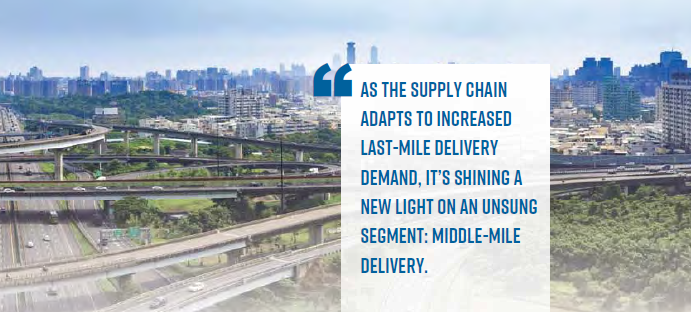There’s no question last-mile delivery is having its day in the sun. Now that e-commerce is hotter than ever, fleets are fighting for every cost-cutting advantage. As the supply chain adapts to increased last-mile delivery demand, it’s shining a new light on an unsung segment: middle-mile delivery. That’s the part of the supply chain in which goods are transported from a retailer’s warehouse or distribution center to its retail store, and it is slowly gaining popularity as another cost-cutting avenue for retailers.
While the middle-mile is often outsourced, some companies believe bringing this area of their logistics efforts in house can provide opportunities to deliver goods more affordably.
Middle-Mile Trailer Needs
Michael Molitor, Great Dane executive director of business development, says fleets interested in adding autonomous vehicles in their middle-mile operation should be investing in trailers that come equipped with advanced electronic features focused on safety and productivity.
“Many of the largest fleets are becoming more intimately involved in the design phases of new ECUs on trailers,” Molitor says. “In fact, a growing number of forward-looking fleets now purchase every one of their Great Dane trailers with a high compute, central domain controller that is fully integrated with a wired CAN network. This provides fleets with a future comparative operational advantage against their peers, as well as sets them up for higher resale values at the time of trade.” “It is important to note the average life of a trailer is 15 years. A trailer built today will still be on the road in 2035,” he adds. “The technology wave will continue, and trailers need to be built in a way that facilitates upgrades.”
Justin Garver, FleetPulse sales manager, says those fleets will also need to invest in a trailer telematics product that will deliver accurate information on asset utilization. “This includes how many trucks, trailers, drivers, etc. are going to be needed to support their own supply chain requirements,” Garver says. “If you over-buy, that’s just money down the drain immediately. If you under-buy, you’re going to be forced into the rental/leasing market in which case you’re also losing money.
“Through a complete trailer telematics product like FleetPulse, you’ll get KPIs that show you mileage, average loaded weights, and average loaded/unloaded miles, among others. With these performance metrics, you’ll start to see how many assets are being underutilized and you’ll start to see a clearer picture of how many assets you actually need to support your supply chain efficiently.”
Chris Hoyt, FleetPulse product manager, adds that the combination of location data, dwell time and tethered status can provide a fleet valuable insights around its trailers and the efficiency of its distribution process.
“Additional data around cargo load status and door open close can provide you a deeper look into how long a trailer is being detained and possibly not being unloaded as quickly as you’d expect,” Hoyt says.

Potential for Automation
Opening the door for more cost-saving potential, this part of the supply chain is relatively unique because, in many cases, the shipping routes never change. And where there is repetition there is the opportunity for automation.
According to “Is Middle-Mile Delivery a Logistics Frontier or Retail Buzzword,” an article by Michael Waters in Modern Retail, Walmart has already identified its middle mile as a hub of “milk runs” — repeated, easy-to-automate trucking routes. “If the retailer succeeds in populating even just that one leg of the logistics system with self-driving trucks, the company estimates it might be able to cut middle-mile costs by half,” Waters says.
In Freight Waves’ Vishnu Rajamanickam’s article “Will COVID- 19 Accelerate the Adoption of Autonomous Vehicles,” he says the pandemic has kickstarted a number of solutions aimed at potentially reducing human interaction at logistics workplaces. Autonomous driving technology is one of them.
“At the current stage of technology development, self-driving long-haul trucks can be used to automate the middle mile. Highway transit is one of the easiest legs to automate, as the traffic is less chaotic and also more homogeneous,” Rajamanickam says. “Unlike the usual auto players that work on automotive-related problem sets, the autonomous driving segment has seen the advent of several non-traditional players like Google, IBM, Apple, Uber and even Amazon, which have all invested heavily in making autonomous vehicles a reality.”
TuSimple, an autonomous driving technology company, has already partnered with UPS to have autonomous vehicles haul freight for the freight forwarder, Rajamanickam says. “TuSimple, which has been transporting parcels for UPS over the last year (April 2020) between Phoenix and Tucson, Arizona, expanded the program this March [of 2020] to include a new route that connects Phoenix with El Paso, Texas,” he says.
Modern Retail’s Waters also identifies the middle mile as “one of the most practical applications for automated vehicles to integrate into delivery networks … from a safety and industry adoption perspective [middle mile] makes sense.”
Great Dane’s Molitor agrees that the middle mile is a likely portion of the supply chain where automated trucks could take off. “The middle mile is comprised of fixed, predictable movements, mainly on highways, between distribution centers,” Molitor says. “Eliminating the driver provides carriers the ability to –reallocate scarce driver resources to the last mile, which is where drivers are needed to deliver the goods and operate the truck, given urban environments are a higher risk due to the density of people and objects.”
Perhaps an overlooked benefit of tighter middle-mile logistics is the ability to adapt to change, says freight audit service company nVision Global.
“There’s little room for error in middle mile, which lends itself to consolidation and optimization among companies and their partners,” the company says in its article “Forget Last-Mile Delivery, There’s Room for Cost-Cutting in the Middle Mile.” “If Walmart owns their middle mile, they have the ability to adapt. The same goes for third-party intermodal companies that control both local drayage and long-haul trucking segments.”
Thanks to the middle mile’s unique place in the supply chain, it holds the most potential for testing new trucking technologies.
Click to learn more about our complete trailer telematics solution FleetPulse.



